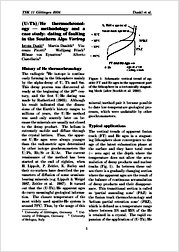(U-Th)/He thermochronology — methodology and a case study: dating of faulting in the Southern Alps
Dani˘sík, Martin
Picotti, Vincenzo
Frisch, Wolfgang
Eynatten, Hilmar von
Castellarin, Alberto
Universitätsverlag Göttingen
Article in Anthology
Verlagsversion
Deutsch
Dunkl, István; Dani˘sík, Martin; Picotti, Vincenzo; Frisch, Wolfgang; Eynatten, Hilmar von; Castellarin, Alberto, 2006: (U-Th)/He thermochronology — methodology and a case study: dating of faulting in the Southern Alps. In: Philipp, S.; Leiss, B; Vollbrecht, A.; Tanner, D.; Gudmundsson, A. (eds.): 11. Symposium "Tektonik, Struktur- und Kristallingeologie"; 2006, Univ.-Verl. Göttingen, S. 45 - 47., , DOI: 10.23689/fidgeo-1894.
 |
View/
|
The radiogeic 4He isotope is continuously
forming in the lithosphere mainly
by the alpha-decay of U, Th and Sm.
This decay process was discovered already
at the beginning of the 20th century,
and the first U/He dating was
made by Rutherford (1905). Although
his result indicated that the dimensions
of the Earth’s history ranges to
millions of years, the U/He method
was used only scarcely later on because
the minerals are usually not closed
to the decay product. The helium is
extremely mobile and diffuse through
the crystal lattices. Thus, the apparent
U/He ages were always younger
than the radiometric ages determined
by other isotope geochronometers like
U/Pb, Rb/Sr or K/Ar. The current
renaissance of the method has been
started at the end of eighties, when
H. Lippolt, P. Zeitler, K. Farley and
their co-workers have described the parameters
of diffusion of some uraniumbearing
minerals (e.g. Lippolt & Weigel
1987, Zeitler et al. 1987). It turned
out that the (U-Th)/He apparent ages
do carry meaningful geological information.
The closure temperature of the
most widely used apatite-He system is
around 70°C. Thus, by the usage of this
mineral/method pair it became possible
to date low-temperature geological processes,
which were undatable by other
geochronometers...

